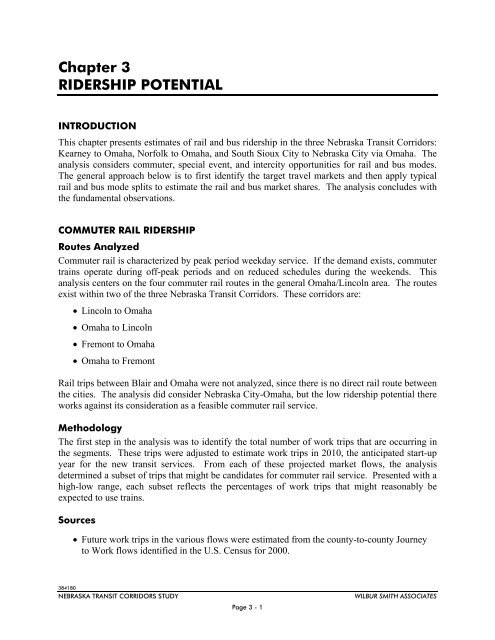NTRAC Final Study - Nebraska Department of Roads - State of ...
NTRAC Final Study - Nebraska Department of Roads - State of ...
NTRAC Final Study - Nebraska Department of Roads - State of ...
Create successful ePaper yourself
Turn your PDF publications into a flip-book with our unique Google optimized e-Paper software.
Chapter 3<br />
RIDERSHIP POTENTIAL<br />
INTRODUCTION<br />
This chapter presents estimates <strong>of</strong> rail and bus ridership in the three <strong>Nebraska</strong> Transit Corridors:<br />
Kearney to Omaha, Norfolk to Omaha, and South Sioux City to <strong>Nebraska</strong> City via Omaha. The<br />
analysis considers commuter, special event, and intercity opportunities for rail and bus modes.<br />
The general approach below is to first identify the target travel markets and then apply typical<br />
rail and bus mode splits to estimate the rail and bus market shares. The analysis concludes with<br />
the fundamental observations.<br />
COMMUTER RAIL RIDERSHIP<br />
Routes Analyzed<br />
Commuter rail is characterized by peak period weekday service. If the demand exists, commuter<br />
trains operate during <strong>of</strong>f-peak periods and on reduced schedules during the weekends. This<br />
analysis centers on the four commuter rail routes in the general Omaha/Lincoln area. The routes<br />
exist within two <strong>of</strong> the three <strong>Nebraska</strong> Transit Corridors. These corridors are:<br />
Lincoln to Omaha<br />
Omaha to Lincoln<br />
Fremont to Omaha<br />
Omaha to Fremont<br />
Rail trips between Blair and Omaha were not analyzed, since there is no direct rail route between<br />
the cities. The analysis did consider <strong>Nebraska</strong> City-Omaha, but the low ridership potential there<br />
works against its consideration as a feasible commuter rail service.<br />
Methodology<br />
The first step in the analysis was to identify the total number <strong>of</strong> work trips that are occurring in<br />
the segments. These trips were adjusted to estimate work trips in 2010, the anticipated start-up<br />
year for the new transit services. From each <strong>of</strong> these projected market flows, the analysis<br />
determined a subset <strong>of</strong> trips that might be candidates for commuter rail service. Presented with a<br />
high-low range, each subset reflects the percentages <strong>of</strong> work trips that might reasonably be<br />
expected to use trains.<br />
Sources<br />
Future work trips in the various flows were estimated from the county-to-county Journey<br />
to Work flows identified in the U.S. Census for 2000.<br />
384180<br />
NEBRASKA TRANSIT CORRIDORS STUDY<br />
Page 3 - 1<br />
WILBUR SMITH ASSOCIATES

















